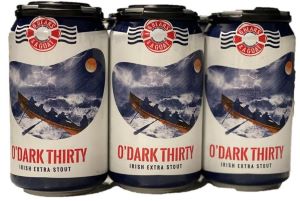Top 10 Classic Irish Dry Stout Brewed in America
This Top 10 Classic Irish Dry Stout list is from the results of the U.S. Open Beer Championship, World Beer Cup, and Ratebeer.com. The best dry stouts have an initial malt and light caramel flavor profile with a distinctive dry-roasted bitterness in the finish. Dry stouts achieve a dry-roasted character through the use of roasted barley. The emphasis of coffee-like roasted barley and a moderate degree of roasted malt aromas define much of the character. Hop aroma and flavor should not be perceived. Dry stouts have medium-light to medium body. Head retention and rich character should be part of its visual character. ABV: 4.10% – 5.30%. IBU: 30-40.

1. O’Dark Thirty – 6 Bears & A Goat Brewing – Virginia
2. Blarney Sisters’ Dry Irish Stout – Third Street Aleworks – California
3. Patio Tools – Cigar City Brewing – Florida
4. Bownes Island Oyster Stout – Holy City Brewing – South Carolina
5. Wooden Coat – Independent Brewing Co. – Maryland
6. DRye Irish Stout – Peekskill Brewery – New York
7. Dubliner – Northern Row Brewery & Distillery – Ohio
8. Irish Setter – Metazoa Brewing Co. – Indiana
9. Stout – King Street Brewing Co. – Alaska
10. Irish Stout – French Broad River Brewery – North Carolina
History of Irish Dry Stout
Irish dry stout, a dark, roasty beer style, emerged in the early 18th century as an evolution of porter, a popular drink among working-class Londoners. Its origins trace back to Guinness, founded in Dublin in 1759 by Arthur Guinness, who began brewing porters before refining the recipe into a drier, more robust stout. By the 1820s, Guinness’s Extra Stout, characterized by its use of roasted barley, moderate bitterness, and creamy texture, became a hallmark of the style. The term “dry” reflects its low residual sweetness and crisp finish, achieved through high attenuation and unmalted barley, which also gave the beer its distinctive jet-black color and coffee-like flavors. The style gained traction in Ireland and beyond, becoming a cultural staple in pubs, where its low alcohol content (around 4-5% ABV) made it a sessionable choice for long evenings.
The 19th and 20th centuries saw Irish dry stout solidify its identity, with Guinness leading alongside competitors like Murphy’s and Beamish, both established in Cork. The introduction of nitrogen gas in the 1950s, pioneered by Guinness for draught dispensing, revolutionized the style, creating a smooth, velvety mouthfeel and iconic creamy head that became synonymous with Irish stout. This innovation, coupled with clever marketing, propelled Guinness to global fame, making it a symbol of Irish heritage. Despite challenges from industrial lagers and craft beer trends, Irish dry stout remains a beloved style, with modern brewers experimenting while staying true to its roasty, balanced core. Its enduring appeal lies in its simplicity and depth, a testament to centuries of refinement.
Top 10 Beers in America – Ales Lagers Specialty Barrel Aged